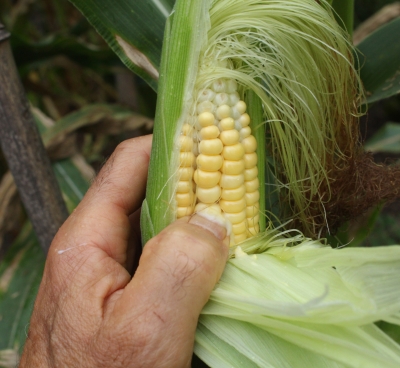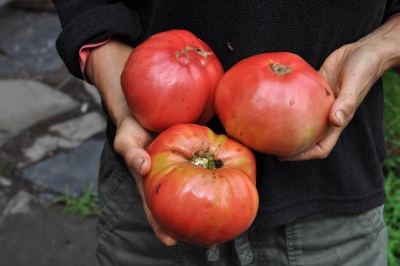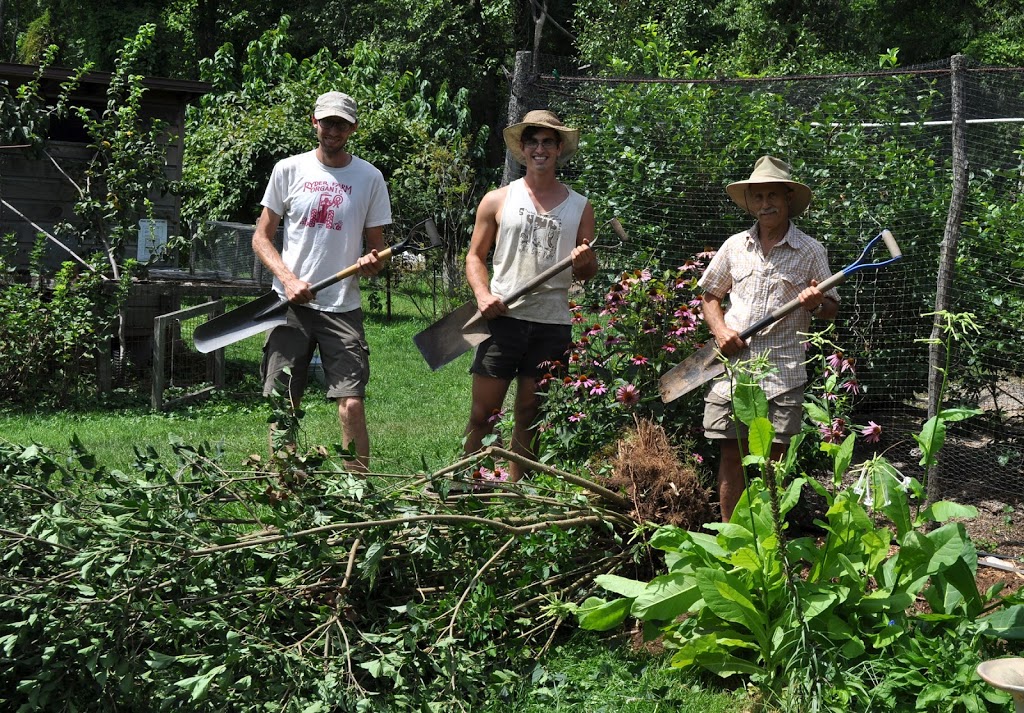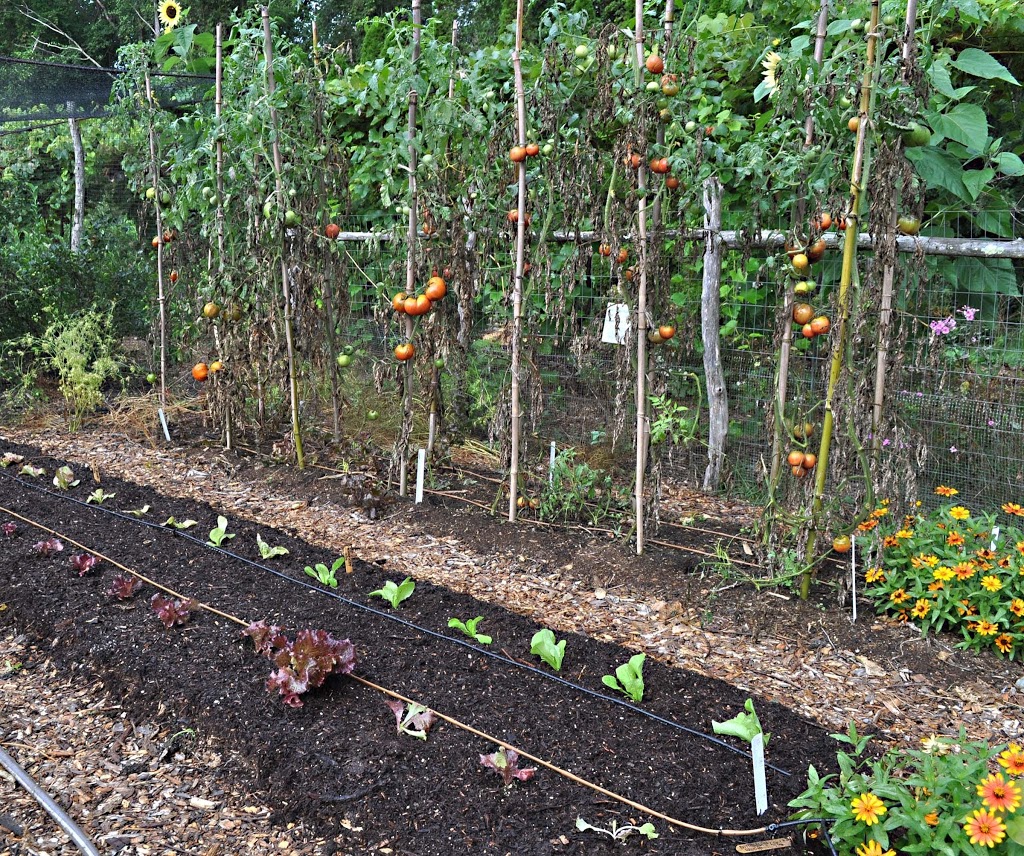Picked At Peak Of Perfection
Tomatoes Vs. Sweet Corn
Some gardeners sit tapping their fingers waiting for the first tomato of the season to finally ripen. I don’t. I’m waiting to sink my teeth into my first-picked ear of sweet corn.
Not that my tomatoes don’t taste really good, but they’re also good all winter dried or canned, as is or as sauce. Or just frozen.
An ear of sweet corn, though, captures the essence of summer. Not just for flavor and texture. It’s the whole ritual of peeling back the husks and snapping them off at their bases, brushing away the silk before steaming the ears, and then, holding an ear at each end, biting off kernels from one end to the other like an old fashioned typewriter carriage. (An image perhaps unknown to readers below a certain age.)
An art to harvesting corn at the just-ripe stage, and anxiousness for that first taste, make harvesting, especially early in the season rather tenuous. I do early planning for that first taste by counting the days-to-maturity from when I planted. Problem is that the days listed on seed packets vary: One seed company lists days to maturity for Golden Bantam, the variety I grow, at 75 days; another lists it at 85 days; another at 78 days; and yet another, more realistically, at 70 to 85 days. It depends on where the variety is grown and how the season develops.
The real countdown begins when tassels first appear atop the stalks. Harvest will be about 3 weeks hence.
Then it’s time to keep an eye out for drying tassels at the end of an ear. Once that happens, the time is near. That right moment is critical because harvested too soon, and the kernels have little taste. And this is among those fruits — yes, corn is a fruit, botanically — that will not ripen at all following harvest. Harvested too late, and the kernels are tough and starchy.
That exact right moment for harvest is when the ear feels “full” when grasped in my hand and a kernel on the peeled-back husk, with the ear still attached to the stalk, oozes a milky fluid when pressed with the thumbnail. If all these systems are go, it’s time to snap off the ear and whisk it to the waiting pot of steaming water.
Golden Bantam is a non-hybrid variety. Like other non-hybrids, a planting does not ripen all at once, which is not a good commercial characteristic. It’s fine for me, though, because between staggered plantings and a wide window for harvest for each planting, I intend to be eating Golden Bantam corn, a favorite for many gardeners since its introduction in 1906, for weeks to come.
Watermelon, Are You Ripe
Besides the first harvest of Golden Bantam, which I’ll be enjoying by the time you read this, I’m also eagerly awaiting the first harvest of watermelon, which, according to days-to-maturity listed on the seed packet, 65-75 days, I should have already been eating. (I sowed seeds indoors in pots in mid-May but it’s been a relatively cool growing season.)
While I’m confident in harvesting sweet corn at just the right moment, not so for harvesting watermelon, another fruit that will not ripen at all once harvested. Yes, I know all the published indicators of ripeness: drying up of the tendril closest where the fruit is attached to the vine; a dull thud, rather than a tighter, ringing or hollow sound, when rapped with my knuckles; and a yellow or cream-color of the fruit where it rests against the ground, and a toughening of the skin there, enough to resist indentation with a thumbnail. (The thumbnail is evidently a useful harvest tool.)

A ripe watermelon?
Still, I’m not confident about harvesting watermelons on time, and not even just the first ones to ripen. The trial and tribulation is worth it. I hope to be harvesting and eating ripe watermelon also by the time you read this. (Update: I did and it was.)
Tomatoes, You Are Ripe
In contrast to harvesting Golden Bantam corn and watermelon (I grow the variety Blacktail Mountain), tomatoes are cinch to harvest. Except for some green-ripe varieties, which I don’t grow, tomatoes turn their characteristic shade of red when ripe.
Tomatoes can even be harvested underripe to ripen off the vine. Research has shown that when a tomato is about half green and half pinkish-red on the vine, a layer of cells form across the stem of the tomato sealing it off from the main vine. Then nothing that can move from the plant into the fruit, so the fruit can ripen to perfection.
I came across some older research (J. Amer. Hort. Soc. 102:724-731. 1977) showing that the best-tasting tomatoes are those thoroughly vine-ripened. Duh. I knew that, and will harvest only vine-ripened tomatoes.




Another great post! I had no idea about the tomatoes. I have tried also growing melons in the past here in southern Maine, with mixed results. Now that I have my own greenhouse, I will try again next year. I doubled the number of raised boxes recently after bumping out my 6 ft. cedar fencing enclosure. I now have room for a modest corn crop. I had heard that golden bantam was a good all around corn to try. Do you keep seed from your corn from year to year ever? I am learning how to save seed, but I find that many OP seeds I buy are quite variable in growth and flavor. Probable because I am sourcing from other parts of the country. I may have better luck at Common Ground Fair seed swap later this month. Also, will you be posting on cultural practices for fruit trees at the end of season? My trees are stressed from lack of rain here in Portland, but I did find that using Myco-blast and Actinovate as a drench seemed to help them get through the season. A great year for plums and peaches, but awful for the apples.
Dry year! Not here. We had perfectly timed rainfall. No matter, though, I use plenty of mulch — wood chips, hay, leaves, according to what’s available and my whim — around my fruit trees.
I don’t save corn seed. To do so, you have to save ears from a few plants. For why, see Carol Deppe’s excellent book Breed Your Own Vegetable Varieties. I don’t want to sacrifice eating any of the ears.
My uncle in Southern Indiana grew delicious watermelons. When I went to visit around Labor Day, we would pluck a straw off an old broom and proceed to test the melons for ripeness. I didn’t pick the ones where the straw didn’t turn and line up lengthwise so never compared them to the ones that did. It’s not scientific but every one we picked was ripe. He grew so many we ate the hearts out and left the rest for the compost pile.
I’m not sure what you did with the straw. Please explain. I’ll try anything that simple. (After harvesting my first melon, others have been dead ripe. But still, more information is better.)
1. Get a straw from your broom, not a synthetic broom-has to be the real thing. Best to get one that is straight-if it curves downward that can inhibit action. 2. Place the straw lengthwise along the watermelon. 3. Give it time to see if it turns all the way perpendicular. Some place it across the watermelon and wait for it to turn lengthwise of the melon. I only tried it one way. The more it turns and lines up, the more ripe it is. If nothing else, it was fun going out and testing them. If you go to You Tube and search “CHECKING WATERMELON WITH A STRAW FOR RIPENESS” you’ll find several people demonstrating it along with those who check the tendril, belly, thumping, etc. Of course the problem is they can be overripe and do the same thing. I think this is more of a southern thing along with putting peanuts in a bottle of sodie pop (Cola)-it’s a sweet & salty thing and another great memory.
Yum! You truly are enjoying the fruits of your labor. My tomatoes are finally beginning to turn! I do not grow corn or melon. Perhaps I am missing out.
Yes, you’re missing out on delectable corn if you do not grow Golden Bantam. Grow a few hills and see what I mean.